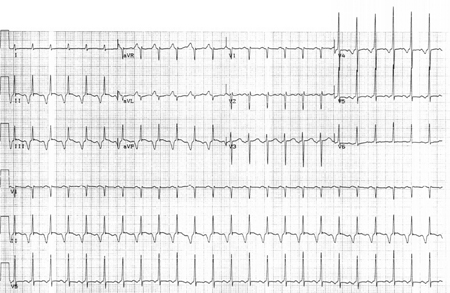Hypotension is any blood pressure (BP) that is below the normal expected for an individual in a given environment.
There is no single numerical cut-off universally accepted as representing hypotension. For example, while systolic BP <90 mmHg may be considered hypotensive for someone with 'normal BP' of 120 mmHg, many healthy young adults will have a resting BP at or potentially below this level and will not be considered hypotensive. As a result, it is difficult to estimate the prevalence.
Background history and accompanying clinical findings should be considered, bearing in mind that many common illnesses present atypically in older adults, without characteristic symptoms such as pain.[1]Gibson SJ, Helme RD. Age-related differences in pain perception and report. Clin Geriatr Med. 2001 Aug;17(3):433-56, v-vi.
http://www.ncbi.nlm.nih.gov/pubmed/11459714?tool=bestpractice.com
Hypotension can be the first sign of a serious acute illness (such as myocardial infarction, sepsis, or gastrointestinal haemorrhage).[2]Sigurdsson E, Thorgeirsson G, Sigvaldason N. Unrecognised myocardial infarction: epidemiology, clinical characteristics and the prognostic role of angina pectoris. The Reykjavik Study. Ann Intern Med. 1995 Jan 15;122(2):96-102.
http://www.ncbi.nlm.nih.gov/pubmed/7993002?tool=bestpractice.com
Once acute causes have been excluded, other chronic or recurring causes should then be investigated.
Blood pressure measurement
It is essential to use an appropriate cuff size for BP measurements. Using a cuff that is too small (under-cuffing) may cause overestimation of BP and may further mask a period of hypotension; while use of a cuff that is too large (over-cuffing) can lead to falsely low BP readings with subsequent unwarranted investigation.[3]Ishigami J, Charleston J, Miller ER 3rd, et al. Effects of cuff size on the accuracy of blood pressure readings: the cuff(SZ) randomized crossover trial. JAMA Intern Med. 2023 Oct 1;183(10):1061-8.
https://pmc.ncbi.nlm.nih.gov/articles/PMC10407761
http://www.ncbi.nlm.nih.gov/pubmed/37548984?tool=bestpractice.com
If the patient is not hypotensive at the time of assessment, lying and standing BP recordings should be carried out in order to determine if orthostatic hypotension is present. The patient should rest supine for 5 minutes before lying BP measurement.[4]Frith J. Diagnosing orthostatic hypotension: a narrative review of the evidence. Br Med Bull. 2015 Sep;115(1):123-34.
https://www.doi.org/10.1093/bmb/ldv025
http://www.ncbi.nlm.nih.gov/pubmed/25995335?tool=bestpractice.com
A systolic BP drop of 20 mmHg or a diastolic BP drop of 10 mmHg occurring within 3 minutes of orthostasis is considered significant.[5]McEvoy JW, McCarthy CP, Bruno RM, et al. 2024 ESC guidelines for the management of elevated blood pressure and hypertension. Eur Heart J. 2024 Oct 7;45(38):3912-4018.
https://academic.oup.com/eurheartj/article/45/38/3912/7741010
[6]Freeman R, Wieling W, Axelrod FB, et al. Consensus statement on the definition of orthostatic hypotension, neurally mediated syncope and the postural tachycardia syndrome. Clin Auton Res. 2011 Apr;21(2):69-72.
http://www.ncbi.nlm.nih.gov/pubmed/21431947?tool=bestpractice.com
Most automatic sphygmomanometers overestimate BP in patients with atrial fibrillation, because they record the highest systolic pressure rather than an average over several cardiac cycles. Palpate the patient’s pulse to exclude arrhythmia before using an automatic sphygmomanometer.[5]McEvoy JW, McCarthy CP, Bruno RM, et al. 2024 ESC guidelines for the management of elevated blood pressure and hypertension. Eur Heart J. 2024 Oct 7;45(38):3912-4018.
https://academic.oup.com/eurheartj/article/45/38/3912/7741010
Pathophysiology
BP is determined by cardiac output (the product of heart rate and stroke volume) and total systemic vascular resistance. Hypotension occurs when the cardiac output decreases and/or the systemic vascular resistance decreases. Hypotension is usually due to:
Decreased effective circulating volume (hypovolaemia)
Impaired cardiac output due to heart pump dysfunction (cardiogenic)
Impaired cardiac output due to obstruction to cardiac filling (obstructive)
In many cases, more than one mechanism is present (e.g., a patient with chronic heart failure who presents with a gastrointestinal bleed may have evidence of both hypovolaemia and reduced cardiac output).
Persistent hypotension can lead to shock, a state of reduced end-organ oxygenation owing to an imbalance between tissue oxygen demand and delivery.
Initial management considerations
Liaison with nursing staff, with regard to maintenance of patient safety while investigations are underway, is prudent. In particular, patients who are hypotensive in the setting of sepsis may have an accompanying delirium increasing their risk of falls and injury.[7]Haerlein J, Dassen T, Halfens RJ, et al. Fall risk factors in older people with dementia or cognitive impairment: a systematic review. J Adv Nurs. 2009 May;65(5):922-33.
http://www.ncbi.nlm.nih.gov/pubmed/19291191?tool=bestpractice.com
[8]Corsinovi L, Bo M, Ricauda- Aimonino N, et al. Outcomes in elderly patients admitted to an acute geriatric unit. Arch Gerontol Geriatr. 2009 Jul-Aug;49(1):142-5.
http://www.ncbi.nlm.nih.gov/pubmed/18674824?tool=bestpractice.com
It is often difficult to exclude or confirm the presence of shock without close monitoring of vital signs, including BP, heart rate, and urinary output. Therefore, consideration should be given to the most appropriate setting required to monitor, nurse, and medically manage the hypotensive patient.
